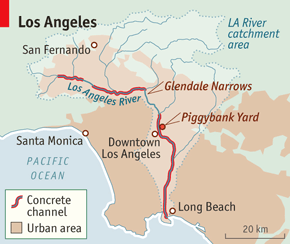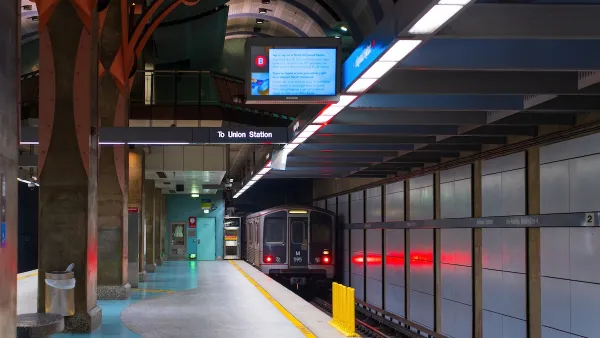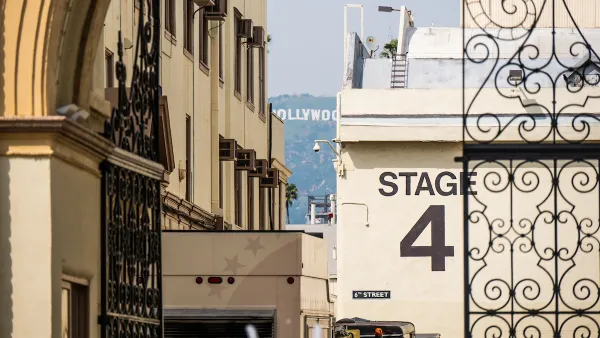The moribund state of the Los Angeles River reflects the zeitgeist of the city that it runs through, says The Economist. A mile wide but an inch deep, revitalization proposals are too conceptual at best and too feeble at worst.
"Once it emerges from the San Fernando Valley to run through downtown Los Angeles and various industrial cities before spilling into the Pacific near the port of Long Beach, the 'river' is really a pathetic trickle composed almost entirely of treated sewage. It runs in a concrete channel under freeways and along railway tracks, invisible to most people. Graffiti mark the turfs of rival gangs. It smells not of fresh water but of hobo urine, slaughterhouses and factories. [...] A Parisian, Londoner or New Yorker might find this sad-no quays, cafés, promenades, boat cruises," states the article.
"Nothing about it is natural; and yet nature constantly reclaims parts of it. In a city that worships, without irony, organic, local food grown with distant water and bodies simultaneously toned by holistic yoga and cosmetic surgery, the river mirrors what it runs through."
FULL STORY: Through culverts to the sea

Planetizen Federal Action Tracker
A weekly monitor of how Trump’s orders and actions are impacting planners and planning in America.

Restaurant Patios Were a Pandemic Win — Why Were They so Hard to Keep?
Social distancing requirements and changes in travel patterns prompted cities to pilot new uses for street and sidewalk space. Then it got complicated.

Map: Where Senate Republicans Want to Sell Your Public Lands
For public land advocates, the Senate Republicans’ proposal to sell millions of acres of public land in the West is “the biggest fight of their careers.”

Maui's Vacation Rental Debate Turns Ugly
Verbal attacks, misinformation campaigns and fistfights plague a high-stakes debate to convert thousands of vacation rentals into long-term housing.

San Francisco Suspends Traffic Calming Amidst Record Deaths
Citing “a challenging fiscal landscape,” the city will cease the program on the heels of 42 traffic deaths, including 24 pedestrians.

California Homeless Arrests, Citations Spike After Ruling
An investigation reveals that anti-homeless actions increased up to 500% after Grants Pass v. Johnson — even in cities claiming no policy change.
Urban Design for Planners 1: Software Tools
This six-course series explores essential urban design concepts using open source software and equips planners with the tools they need to participate fully in the urban design process.
Planning for Universal Design
Learn the tools for implementing Universal Design in planning regulations.
Heyer Gruel & Associates PA
JM Goldson LLC
Custer County Colorado
City of Camden Redevelopment Agency
City of Astoria
Transportation Research & Education Center (TREC) at Portland State University
Camden Redevelopment Agency
City of Claremont
Municipality of Princeton (NJ)






























